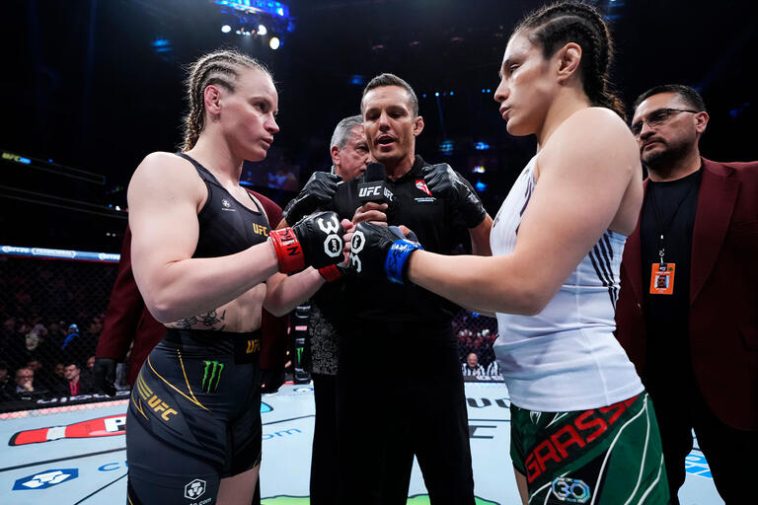In the time leading up to Noche UFC, the MMA organization’s second annual tribute to Mexican Independence Day, an unexpected event occurred. As an MMA fan who first grew interested in the sport during the heyday of McGregor and deepened my love for it during the lockdown period, I found myself for the first time breaking tradition. No episode of Embedded had caught my eye, neither the press conference on Thursday nor the ceremonial weigh-ins on Friday held my attention. The thrilling anticipation I often felt on the eve of a fight night was just not there. In retrospect, my indifference stemmed from a type of uncertainty which usually results in caution than interest.
Saturday Night’s fights were a puzzle, causing confusion among fans including myself. Beginning with its eclectic title: UFC 306: Riyadh Season Noche UFC, everything about the event seemed baffling. The highlight of the promotional campaign was not the homegrown star Sean O’Malley or Mexico’s own Alexa Grasso, but The Sphere, which was consistently mentioned throughout the broadcast. A fight night, inspired by Mexico but morphed into a numbered pay-per-view, sponsored by a Saudi Arabian festival, and boasting its venue rather than its fights, left me with unanswerable questions.
However, the professional integrity of UFC, an organization known for its masterful production in combat sports, shed light on these mysteries. Initial claims that the event’s most affordable seats were priced over a whopping $2000 sparked concerns. Would enthusiastic Mexican and Mexican-American aficionados be financially sidelined in favor of casual observers with well-padded wallets and business expense accounts? This apprehension was put to rest when the audience cheered wildly for Raúl Rosas Jr as he advanced towards the ring, kick-starting the first preliminary match.
Doubt overcame me when I discovered four unknown athletes were slated to open the main card, prompting a bewildered query– who are these guys? Contrary to expectation, these matches proved to be the most exciting, as fixtures involving Esteban Ribovics and Daniel Zellhuber won Fight of the Night accolades – accolades that could have easily gone to Ronaldo Rodríguez and Ode’ Osbourne.
As the match progressed, I found it disconcerting that The Sphere, the host venue, was receiving more promotion than the bantamweight champion who was headlining the event. However, as the night wore on, the anticipation of what such a spectacle might look like yielded far more interest than the predictable outcome of the main event.
One question, though, loomed over me– why did UFC choose Mexican Independence Day for this historic debut at the Sphere? As the event approached, I could not help but wonder if a headline bout featuring the likes of Conor McGregor or Jon Jones on their triumphant return could’ve created a bigger pop culture event. If held during International Fight Week, the marketing would have been less complex, and the legacy of UFC 300 could have led to a more substantial line-up.
Regardless, these concerns were alleviated as the UFC showcased the charm and value of the Sphere in ways that no preview or promotional brandishing could have achieved. The engaging narrative that unfolded throughout Noche UFC couldn’t have been better portrayed in terms of choice of venue and timing.
Six cinematic shorts, crafted by the Oscar-winning Carlos López Estrada’s Antigravity Academy superbly utilized The Sphere’s immersive capacity. Teleporting viewers on a journey through Mexico’s past, these films portrayed a stunning display of ancient societies, legendary freedom fighters, religious traditions, renowned fighters, and diverse aspects of Mexican culture– all under a captivating magical aura.
Joining the cultural celebration, eight Mexican Octagon Girls of either first or second generation flaunted beautiful outfits inspired by their native land. The actual matches, other than the main event, did justice to the pomp and show that defined the night. It demonstrated the theatrics that high-stake MMA confrontations offer, particularly when they reflect a culture’s resilience.
After a short film depicting the tale of indigenous warriors, the original defenders of the land now known as Mexico, we saw Mexican flyweight Ronaldo Rodriguez emerge victorious over Ode’ Osbourne following two near-ends due to submissions. Subsequently, Daniel Zellhuber, hailing from Mexico City, put up a fast-paced fight against Argentina’s Esteban Ribovics. Despite losing in the official scorecards, his relentless tenacity won over spectators who had never seen him fight before.
Although Alexa Grasso’s performance failed to meet expectations, bouts kept me on the edge of my seat round after round, subconsciously hoping to witness Valentina Shevchenko submit to defeat. UFC 306 produced iconic scenes that will be indefinitely imprinted in my memories just like its predecessor UFC 300. But against all anticipation, this card’s success lay not in its hyped build-up but in its spontaneous, thrilling moments.
While UFC President Dana White described Noche UFC as ‘the greatest sporting event of all time’, the actual dimensions of its success are largely subjective. In a post-event press conference, White conceded that it’s the audiences who would ultimately judge the event’s effectiveness.
To me, grand claims like these are somewhat intimidating; However, I can confidently state that Noche UFC was the most splendidly produced televised sporting event I have ever witnessed – outshining Super Bowls, NBA Finals, and WrestleManias. It was an event that, despite my initial skepticism, thoroughly exceeded expectations and will forever remain memorable.


